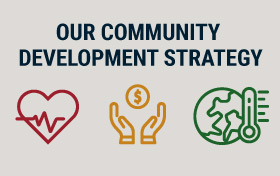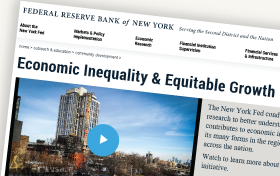On April 3, 2017, the New York Fed held an on-the-record press briefing about household borrowing and student debt. This three-part presentation delved into: (1) household borrowing trends, (2) student debt growth, delinquencies and repayment and (3) the relationship between homeownership, student debt and educational attainment.
New York Fed President William C. Dudley opened the briefing with remarks, which were then followed by a presentation delivered by New York Fed economists Wilbert van der Klaauw, Donghoon Lee and Rajashri Chakrabarti.
This section assessed major trends in household debt and credit. In the fourth quarter of 2016, household debt inched within $100 billion of its 2008 peak of $12.7 trillion, and is expected to reach a new high this year. Although total household indebtedness is nearing its previous peak, the American balance sheet looks quite different today – in terms of the types of debt borrowed and who is borrowing it.
Shifts in types of debt: A key change is that borrowers have shifted away from housing-related debt (such as mortgages) toward auto and student loan debt. Housing-related balances are still nearly $1 trillion below the 2008 peak, but this gap was nearly entirely offset by higher auto loan balances (+$367 billion) and student loans (+$671 billion).
Changes in types of borrowers: Recently, debt balances have moved to older and more creditworthy borrowers. Borrowers age sixty and older now hold 22.5% of the total outstanding balances, compared to 15.9% in 2008. Further, there has been substantial growth in the balances held by prime borrowers, while balances held by subprime borrowers have declined.
The overall improvement in credit quality has resulted in low and still-improving delinquency rates. However, as President Dudley said in his opening remarks: “Notwithstanding this overall rosy picture, the improvement in aggregate debt quality and performance conceals important underlying changes in debt holdings that could be consequential, with implications for the housing market and for consumer spending over the longer term.”
This section provided an overview of student debt today—highlighting that they stood at $1.3 trillion at the end of 2016, an increase of about 170% from 2006. The key factors contributing to these rising balances are that: more students are taking out loans, the loans are for larger amounts, and the speed with which borrowers repay their debts has slowed down. Of note:
- New debt originations have continue to increase—2015 graduates with student loans left school with about $34,000, up from only $20,000 just ten years before.
- While about 36% of student debt holders owed less than $10,000, and 65% owed less than $25,000, only about 5% of student debt holders owed more than $100,000 in debt in 2016. Yet these big-balance borrowers account for nearly 30% of the total balances outstanding.
- Defaults peaked among those who left school in 2011 and appear to have improved for later cohorts, but the longer-term performance remains to be seen.
- Although defaults are improving, the pay down progress of recent cohorts continues to decline.
The final portion of the press briefing focused on educational attainment, student loans and homeownership. These findings show that college education is associated with markedly higher homeownership rates regardless of debt status, which increases at each additional level of college attainment. However, having student loans dampens homeownership rates at every level of education, and higher debt balances are associated with even lower homeownership rates. The presentation also found that college education appears to mitigate the impact of economic background on homeownership rates.













